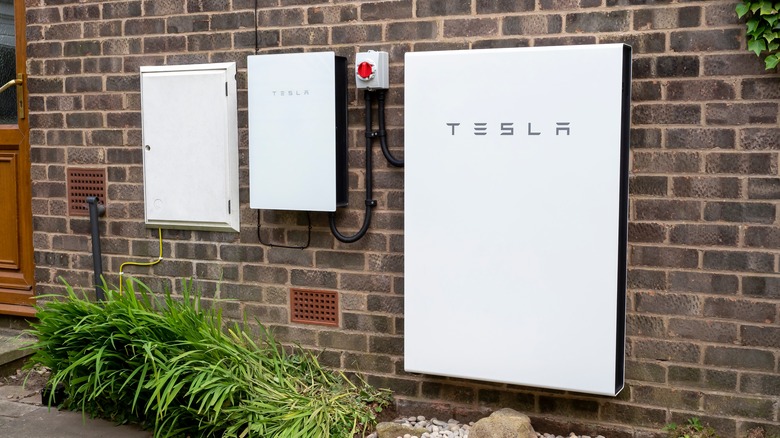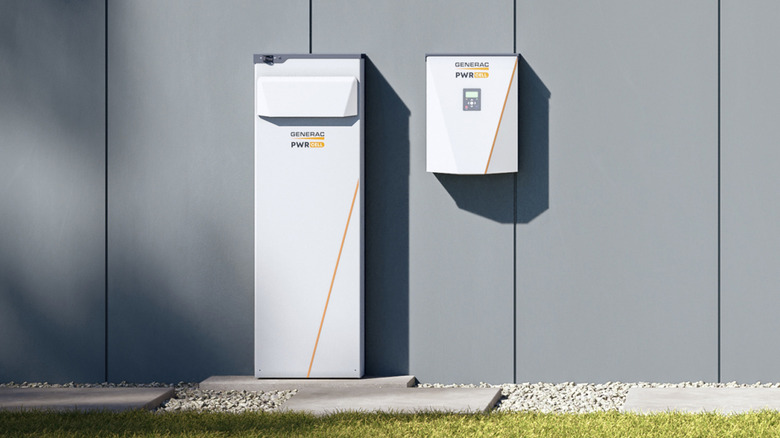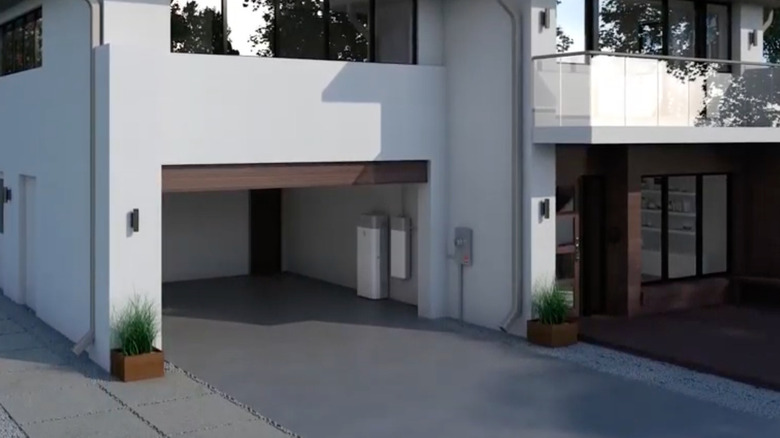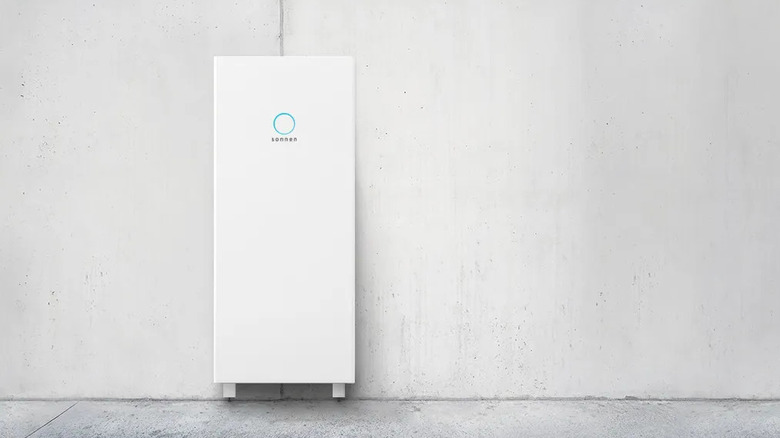4 Tesla Powerwall Alternatives To Check Out In 2023
Solar panels have long been considered a great way to cut down on energy costs and reduce your impact on the environment. Unfortunately, the sun only shines for so many hours a day, so there will be times when your panels are producing more energy than you need and other times when nothing is being produced at all. Luckily there's a simple solution: install a big battery that will charge up when the sun is shining and distribute that power long after the ball of gas has called it a day.
Tesla has cornered a good chunk of that market with its Powerwall, which can keep your home going for a full day, costs over $11,000 before installation equipment is factored in, and comes with a 10-year warranty. That warranty promises that after a decade, your home's battery won't have lost any more than 30% of its capacity. You can also chain up to 10 of them together to increase your storage capacity.
In theory, a home can become energy self-sufficient by combining enough solar panels with storage solutions like the Powerwall. At worst, they also provide a solid backup if you're in an area prone to power outages. But Tesla isn't the only game in town, and there are several alternatives to the Powerwall available.
Generac PWRcell system
Generac's PWRcell system is one of the most customizable on the market. The batteries are modular, and each one can store around 3 kWh of charge. These are then fitted to a "cabinet," and you can just order the amount you need. A cabinet can store anywhere from three to six battery packs, so that's nine to 18 kWh of capacity. Four or more of these modules will give you more capacity than you get with the Tesla Powerwall.
A maximum of two cabinets can be fitted, which provides up to 36 kWh of power. Another benefit of this system is the ability to easily expand the amount of power you can store. This mitigates more of an issue with these systems, which is the enormous initial outlay. With the PWRcell system, you can just start with three battery packs and add more as time goes on or your needs change.
On the downside, you can't use this with your existing solar panels. While the fact it is coupled with Generac's own solar system makes it more efficient than plug-and-play systems, it also adds a lot of expense. This might be a great option if you're installing a solar system and battery storage from scratch, but you may be better off looking at other systems if you already have panels in place.
SunPower SunVault
The basic version of the SunPower SunVault is just shy of a Powerwall+'s battery capacity at 13 kWh. The larger version doubles that capacity, offering 26 kWh of energy storage. It can also pump out more power than the Powerwall — 1 KW more to be precise — so you can run more large appliances with the SunVault than you can with Tesla's storage solution. On top of everything else, you can get your hands on a SunvVault pretty quickly. There are no reported wait times. This contrasts with the Powerwall which, like many popular Tesla products, has a bit of a waiting list.
On the downside, that capacity comes at a price. The SunVault is currently one of the most expensive systems currently on the market. Depending on the deal you get, buying two Powerwalls may be cheaper than getting the largest SunVault. On top of that, the battery pack is also slightly less efficient than the Powerwall. You'll get about 90% of the electricity you put into a Powerwall back, while the SunVault only gives you around 85% back. It also has far fewer features than the highly polished Tesla products. In terms of warranty, there is no difference between the main terms of Sunpower's SunVault warranty and that of the Tesla Powerwall. Both batteries are guaranteed to have at least 70% of their original capacity after a decade of use.
sonnenCore+ battery
A couple of years ago, German company Sonnen decided to give Tesla some competition and launched the sonnenCore — a whole home battery. These days, the sonnenCore has been supplanted by the sonnenCore+, which can be attached to your current solar system if you have one, and will provide a way to store up to 10 kWh or 20 kWh of capacity, depending on the model. If you haven't got any working solar panels, you can still run a backup system based around the sonnenCore+. The battery will simply charge itself from your regular electricity supply instead.
If you're using this battery as a backup solution, it takes less than half a second to kick in, which means most of the devices in your home won't even have time to shut off. It's also pretty versatile, offering a wide selection of operating modes so you can ensure it's serving its intended purpose as efficiently as possible. To make things even simpler, these settings can be adjusted via an app, though Sonnen's battery is far from unique in this regard. If you want to increase capacity, multiple sonnenCores can be installed together.
In terms of battery, Sonnen is offering essentially the same standard warranty you will get with a Tesla Powerwall. After 10 years, your battery should, at worst, have 70% of the capacity it started out with.
Panasonic EverVolt 2.0
Tesla's Powerwall isn't cheap, but it does cost less than the Panasonic EverVolt 2.0. You do get more for your money though. A Powerwall+ can store a maximum of 13.5 kWh of electricity when set up, while the larger capacity EverVolt 2.0 can store 17.1 kWh when set up in an AC-coupled system. If you configure it in a DC-coupled system with a solar inverter, the storage capacity can be boosted to a staggering 102 kWh.
You don't need a set of solar panels or other energy-generating methods for Panasonic's battery to be useful. It can charge itself from the grid and serve as a useful backup solution if you live in an area with regular outages, or somewhere where an outage can mean long periods without power. There are some downsides. As mentioned, the Powerwall is a lot cheaper with the EverVolt 2.0 setting the average user back between $15,000 and $20,000 once installation work is taken into account.
In terms of scalability, you can jam 10 Powerwalls together, while a maximum of three EverVolt 2.0s can work together in tandem — though the staggering capacity in certain configurations means you probably won't need more than one unit. Finally, there's the warranty. Both come with 10-year warranties but Panasonic only guarantees the battery will not lose more than 40% of its capacity in that time.




